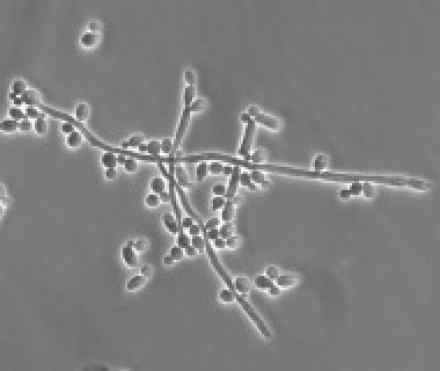
What is it?
A vaginal yeast infection is a type of vaginitis — inflammation of the vagina — characterized by vaginal irritation, intense itchiness and vaginal discharge. A vaginal yeast infection affects your vagina and the tissues at the opening to your vagina (vulva).
Vaginal yeast infection — also called candidiasis — is very common. As many as 3 out of 4 women experience a yeast infection at some point in their lifetimes. Many women experience two or more yeast infections.
A vaginal yeast infection isn't considered a sexually transmitted disease, although the fungus that causes the condition can be spread through oral-genital contact. Treatment is usually effective, unless you have recurrent yeast infections — four or more in a single year. In that case, you may need a longer course of therapy and to follow a maintenance regimen.
Symptoms
Yeast infection symptoms range from mild to severe, including:
- Itching and irritation in the vagina and at that entrance to the vagina (vulva)
- A burning sensation, especially during intercourse or while urinating
- Redness and swelling of the vulva
- Vaginal pain and soreness
- Thick, white, odour-free vaginal discharge with a cottage cheese appearance
Causes
A vaginal yeast infection is caused by the fungus candida. Candida is a microorganism that's normally present in your vagina, along with bacteria. Your vagina naturally contains a balanced mix of yeast and bacteria. Lactobacillus bacteria produce acid, which discourages overgrowth of yeast in the vagina. But disruption of the healthy balance can result in an overgrowth of yeast. Too much yeast in your vagina can lead to vaginal itching, burning, and other classic signs and symptoms of a yeast infection.
Overgrowth of yeast can result from:
- Antibiotic use, which leads to a decrease in the amount of lactobacillus bacteria in your vagina and a change in your vaginal pH that allows yeast to overgrow
- Pregnancy
- Uncontrolled diabetes
- Impaired immune system
- Anything that changes the type and amount of bacteria normally present in the vagina, such as douching or irritation from inadequate vaginal lubrication
Most often, yeast infection results from a type of candida fungus known as Candida albicans. Sometimes, however, a different type of candida fungus might be the cause of symptoms. Candida albicans responds well to typical treatments for yeast infections. Other types of candida, however, sometimes respond poorly to conventional therapies and may require more aggressive treatment.
A yeast infection can be sexually transmitted, especially through oral-genital sexual contact. However, yeast infection isn't considered a sexually transmitted disease because it happens in celibate women and the candida fungus is naturally present in the vagina.
Risk factors
Among the things that increase your risk of developing a yeast infection are:
- Antibiotic use. Yeast infections are common in women who take antibiotics. Broad-spectrum antibiotics kill healthy bacteria in your vagina, which can lead to the overgrowth of yeast.
- Increased estrogen levels. Yeast infections appear to occur more frequently in women with increased estrogen levels, for instance, in women who are pregnant, those taking high-dose estrogen birth control pills or those taking estrogen hormone therapy.
- Uncontrolled diabetes. In women who have diabetes, those with poorly controlled blood sugar levels are more likely to develop yeast infections than are women who have diabetes under control.
- Impaired immune system. In women who are immunocompromised — such as by corticosteroid therapy or by HIV infection — yeast infections are more likely to occur.
- Being sexually active. Although yeast infections aren't considered sexually transmitted diseases, one way the candida organism can be introduced into your vagina is through sexual contact.
Diagnosis
To diagnose a yeast infection, your doctor may:
- Ask questions about your medical history. This might include gathering information about any past vaginal infections or sexually transmitted diseases.
- Perform a pelvic exam. During the exam, you lie on your back on an exam table with your feet resting in supports called stirrups. Your doctor visually examines your external genitals for signs of infection. Next, your doctor places an instrument (speculum) into your vagina to hold the vaginal walls open so that he or she can examine the vagina and cervix. Your doctor may collect a sample of any vaginal discharge for examination under a microscope or to perform a vaginal culture test, if needed. After the speculum is removed, your doctor inserts gloved fingers into your vagina and, while using the other hand to press on your abdomen, examines your other pelvic organs for signs of disease.
- Send a sample of vaginal secretions for testing. For uncomplicated yeast infections, your doctor probably won't perform any sort of laboratory tests. However, if you have recurrent yeast infections, your doctor may be able to prescribe more effective treatment if he or she knows the specific type of yeast that's causing the infection.
References
http://www.healthline.com/health/vaginal-yeast-infection
http://www.medicinenet.com/yeast_infection_in_women_and_men/article.htm
http://www.webmd.com/women/tc/vaginal-yeast-infections-topic-overview
http://www.emedicinehealth.com/vaginal_yeast_infections/article_em.htm

